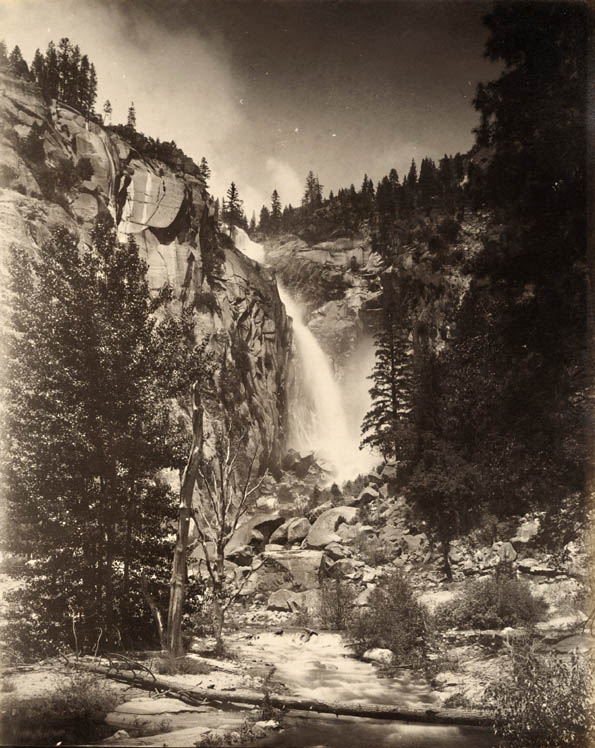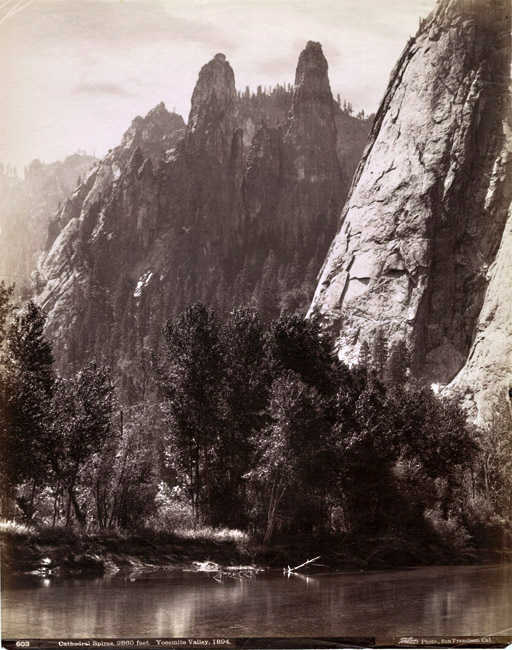By the early 1850s and 1860s photographers were beginning to photograph places in the Western United States which few people--and virtually no non-Native Americans--had ever seen. First by daguerreotype and then through the innovation of the huge mammoth wet collodion glass plates that seemed so suited to these vast spaces.
Carleton Watkins was one the earliest of these pioneers and is credited with the first images to give scope to these amazing landscapes and views. Born in 1829, Watkins had moved to California about 1851 from Oneonta NY. He was one of the many young men drawn to the West during the Gold Rush. In 1853 he moved to San Francisco, where by pure chance he learned how to photograph when he was asked to replace an absent employee in a photography studio, probably the studio of Robert Vance. He later worked for James May Ford in San Jose, taking both daguerreian and ambrotype portraits. He quickly took to the medium, first going freelance and then opening his own studio.
In 1861 Watkins asked a cabinetmaker to build him a huge camera capable of making glass plate negatives measuring 18 by 22 inches. While such cameras were being put to use by a few Europeans (Baldus, Le Gray, Negre, Dr. Murray), this mammoth plate size instrument was unheard of in the Americas at this point. Watkins took the camera on his first photographic expedition to Yosemite in the summer of 1861 and came back with over 30 mammoth plates and a hundred stereo views. After these views were seen, Watkins' reputation was firmly established as the premier American landscape photographer of the 19th century. With this new camera, Watkins was able to capture the enormous scale of the American West, as well as its intricate details. Like Dr. John Murray in India, Watkins expanded the resulting giant prints into multiple-plate panoramas, such as his five-plate panorama of San Francisco in 1863. Other Western photographers, including Muybridge, Weed and Jackson followed suit. The documentation of the early West was totally changed with this one technical innovation by Watkins. He lost most of his negatives to a business partner after economic hardship forced him to default on a loan. The partner then formed a partnership with Isaiah Taber, who proceeded to pint many of Watkins' negatives under his own name. Watkins doggedly rephotographed most of his popular views, calling the reshot images his "New Series". Most of Watkins' work, including all of the "New Series" negatives, was lost in the great San Francisco earthquake and fire of 1908.

Monsen -- Laguna Indian Pueblo, NM
Many of these intrepid pioneers were originally from Europe, such as Eadweard Muybridge, who was born in Kingston-on-Thames in England in 1830. After first traveling to New York City when he was only 20 years old, Muybridge continued on to San Francisco in 1852, where he owned a bookstore and continued to work for a London printing company. Eight years later Muybridge was seriously injured in an accident, and he returned to London to recover, remaining there for the next six years. In 1866 he returned to California with "the finest stock of photographic equipment that his money could buy" and a vision to capture the image of America's West. In 1873, he published 2,000 photographs in the "Catalogue of Photographic Views, Illustrating the Yosemite, Mammoth Trees, Geyser Springs, and Other Remarkable and Interesting Scenery of the Far West". Muybridge also had the distinction, after murdering his unfaithful wife's lover, of claiming temporary insanity and getting off on this legal plea.
Other Englishmen included Charles Roscoe Savage. Savage was born in Southampton, England, on August 16th, 1832. At age 14, he joined the Church of Jesus Christ of Latter-day Saints. He immigrated to the United States during the winter of 1855-56. He initially found work as a photographer in New York City, and headed west the following year. After working first in Nebraska and then Council Bluffs, Iowa, he traveled to Salt Lake City, Utah with his family in the Spring of 1860. In Utah he established a photography studio with a partner, Marsena Cannon, an early Utah daguerreotypist and photographer. A year later, after Cannon moved to Southern Utah, Savage established a new partnership with the artist George Ottinger. Many of Savage's photographs were reproduced in Harper's Weekly newspaper, which helped created a solid reputation for the firm. This partnership continued until 1870. As a photographer under contract with the Union Pacific Railroad, Savage traveled to California in 1866 and then followed the rails back to Utah. He photographed the linking of the Union Pacific and Central Pacific on Promontory Summit, at Promontory, Utah in 1869. This series is considered his most famous work. Savage photographed scenic areas of the west including Yellowstone National Park, Zion National Park, and created many images documenting the growth of Utah towns and cities. Most of Savage's archived photographs, produced by several different early photographic methods, were lost in 1883 in a disastrous studio fire.
One of the most prolific of the Western photographers was American William Henry Jackson. Jackson was born in Keeseville, New York, on April 4, 1843, and was a promising young painter. A broken off engagement after the Civil War pushed Jackson to go West. By 1867 he had settled in Omaha, NE and had a photography business with his brother Edward.
In 1869 Jackson won a commission from the Union Pacific Railroad to document the scenery along their route for promotional reasons. The following year, he got a last-minute invitation to join the 1871 U.S. government survey of the Yellowstone River and Rocky Mountains led by Ferdinand Hayden. Painter Thomas Moran was also part of the expedition, and the two artists worked closely together to document the Yellowstone region.
Using several cameras, including the large mammoth plate version popularized by Watkins, Jackson came back with photographic evidence of western landmarks that had previously seemed fantastic rumor: the Grand Tetons, Old Faithful and the rest of Yellowstone, Colorado's Rockies and the Mount of the Holy Cross. Jackson's photographs of Yellowstone helped convince the U.S. Congress to make it the first National Park in March 1872.
In 1942, he was honored by the Explorer's Club for his 80,000 photographs of the American West. Jackson died that year at the age of 99. Recognized as one of the last surviving Civil War veterans, he was buried at Arlington National Cemetery.
Exhibited and Sold By
Contemporary Works / Vintage Works, Ltd.
258 Inverness Circle
Chalfont, Pennsylvania 18914 USA
Contact Alex Novak and Marthe Smith
Email info@vintageworks.net
Phone +1-215-518-6962
Call for an Appointment














Share This